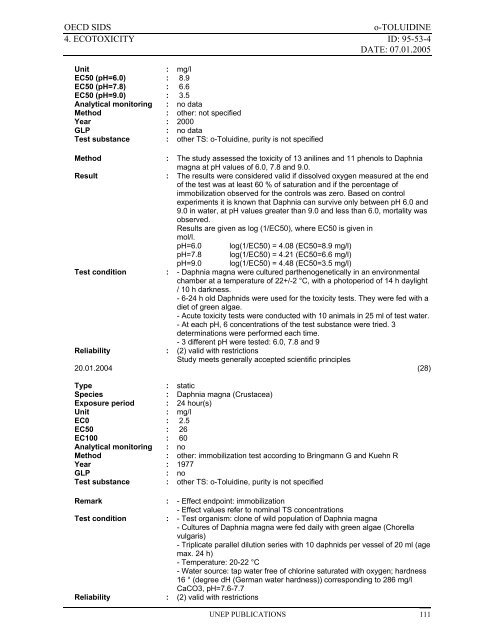o-TOLUIDINE CAS N°: 95-53-4 - UNEP Chemicals
o-TOLUIDINE CAS N°: 95-53-4 - UNEP Chemicals
o-TOLUIDINE CAS N°: 95-53-4 - UNEP Chemicals
Create successful ePaper yourself
Turn your PDF publications into a flip-book with our unique Google optimized e-Paper software.
OECD SIDS o-<strong>TOLUIDINE</strong><br />
4. ECOTOXICITY ID: <strong>95</strong>-<strong>53</strong>-4<br />
DATE: 07.01.2005<br />
Unit : mg/l<br />
EC50 (pH=6.0) : 8.9<br />
EC50 (pH=7.8) : 6.6<br />
EC50 (pH=9.0) : 3.5<br />
Analytical monitoring : no data<br />
Method : other: not specified<br />
Year : 2000<br />
GLP : no data<br />
Test substance : other TS: o-Toluidine, purity is not specified<br />
Method : The study assessed the toxicity of 13 anilines and 11 phenols to Daphnia<br />
magna at pH values of 6.0, 7.8 and 9.0.<br />
Result : The results were considered valid if dissolved oxygen measured at the end<br />
of the test was at least 60 % of saturation and if the percentage of<br />
immobilization observed for the controls was zero. Based on control<br />
experiments it is known that Daphnia can survive only between pH 6.0 and<br />
9.0 in water, at pH values greater than 9.0 and less than 6.0, mortality was<br />
observed.<br />
Results are given as log (1/EC50), where EC50 is given in<br />
mol/l.<br />
pH=6.0 log(1/EC50) = 4.08 (EC50=8.9 mg/l)<br />
pH=7.8 log(1/EC50) = 4.21 (EC50=6.6 mg/l)<br />
pH=9.0 log(1/EC50) = 4.48 (EC50=3.5 mg/l)<br />
Test condition : - Daphnia magna were cultured parthenogenetically in an environmental<br />
chamber at a temperature of 22+/-2 °C, with a photoperiod of 14 h daylight<br />
/ 10 h darkness.<br />
- 6-24 h old Daphnids were used for the toxicity tests. They were fed with a<br />
diet of green algae.<br />
- Acute toxicity tests were conducted with 10 animals in 25 ml of test water.<br />
- At each pH, 6 concentrations of the test substance were tried. 3<br />
determinations were performed each time.<br />
- 3 different pH were tested: 6.0, 7.8 and 9<br />
Reliability : (2) valid with restrictions<br />
Study meets generally accepted scientific principles<br />
20.01.2004 (28)<br />
Type : static<br />
Species : Daphnia magna (Crustacea)<br />
Exposure period : 24 hour(s)<br />
Unit : mg/l<br />
EC0 : 2.5<br />
EC50 : 26<br />
EC100 : 60<br />
Analytical monitoring : no<br />
Method : other: immobilization test according to Bringmann G and Kuehn R<br />
Year : 1977<br />
GLP : no<br />
Test substance : other TS: o-Toluidine, purity is not specified<br />
Remark : - Effect endpoint: immobilization<br />
- Effect values refer to nominal TS concentrations<br />
Test condition : - Test organism: clone of wild population of Daphnia magna<br />
- Cultures of Daphnia magna were fed daily with green algae (Chorella<br />
vulgaris)<br />
- Triplicate parallel dilution series with 10 daphnids per vessel of 20 ml (age<br />
max. 24 h)<br />
- Temperature: 20-22 °C<br />
- Water source: tap water free of chlorine saturated with oxygen; hardness<br />
16 ° (degree dH (German water hardness)) corresponding to 286 mg/l<br />
CaCO3, pH=7.6-7.7<br />
Reliability : (2) valid with restrictions<br />
<strong>UNEP</strong> PUBLICATIONS 111
















